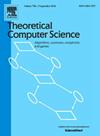Growth of bilinear maps III: decidability
IF 1
4区 计算机科学
Q3 COMPUTER SCIENCE, THEORY & METHODS
引用次数: 0
Abstract
The following notion of growth rate can be seen as a generalization of joint spectral radius: Given a bilinear map with nonnegative coefficients and a nonnegative vector , denote by the largest possible entry of a vector obtained by combining n instances of s using applications of ⁎. Let λ denote the growth rate . Rosenfeld showed that the problem of checking is undecidable by reducing the problem of joint spectral radius.
In this article, we provide a simpler reduction using the observation that matrix multiplication is actually a bilinear map. Moreover, we extend the reduction to show that checking is still undecidable even if s is positive. If there is no restriction on the signs, we can also show that the problem of checking if the system can produce a zero vector is undecidable by reducing the problem of checking the mortality of a pair of matrices. This answers a question asked by Rosenfeld. Beside that, we confirm a remark of Rosenfeld that the problem does not become harder when we introduce more bilinear maps and more starting vectors.
It is known that if the vector s is strictly positive, then the limit superior λ is actually a limit. However, we show that when s is only nonnegative, the problem of checking the existence of the limit is undecidable. This also answers a question asked by Rosenfeld.
We provide a formula for the growth rate λ in terms of the diagonals of matrices corresponding to a special structure called “linear pattern”. A condition is given so that the limit λ exists. This actually provides a simpler proof for the existence of the limit λ when . An important corollary of the formula is the computability of the growth rate, which answers another question by Rosenfeld. Another corollary is that the problem of checking is reducible to the problem of joint spectral radius, via the halting problem, i.e., the two problems are Turing equivalent. Also, we relate the finiteness property of a set of matrices to the notion “linear pattern” of a bilinear system.
双线性映射的增长III:可判定性
下面的增长率概念可以看作是联合谱半径的推广:给定一个具有非负系数和一个非负向量s∈Rd的双线性映射:Rd×Rd→Rd,用g(n)表示一个向量的最大可能条目,该向量是由使用n−1个应用的n个s实例组合而成的。设λ表示增长率limsupn→∞g(n)n。Rosenfeld通过简化关节谱半径问题,证明了检验λ≤1的问题是不可判定的。在本文中,我们通过观察矩阵乘法实际上是双线性映射来提供一个更简单的简化。此外,我们推广了该约简,证明即使s是正的,检验λ≤1仍然是不可判定的。如果符号没有限制,我们也可以通过简化检验一对矩阵的可灭性问题来证明检验系统是否能产生零向量的问题是不可判定的。这回答了罗森菲尔德提出的一个问题。除此之外,我们证实了Rosenfeld的一个评论,即当我们引入更多的双线性映射和更多的起始向量时,问题并没有变得更难。我们知道,如果向量s是严格正的,那么上极限λ实际上是一个极限。然而,我们证明了当s仅为非负时,检验极限是否存在的问题是不可判定的。这也回答了Rosenfeld提出的一个问题。我们提供了一个关于矩阵对角线的增长率λ的公式,该矩阵对角线对应于一种称为“线性模式”的特殊结构。给出了极限λ存在的条件。这实际上提供了一个更简单的证明当s>;0时极限λ的存在性。这个公式的一个重要推论是增长率的可计算性,这回答了罗森菲尔德提出的另一个问题。另一个推论是,检验λ≤1的问题通过停机问题可约化为联合谱半径问题,即两个问题图灵等价。同时,我们将一组矩阵的有限性质与双线性系统的“线性模式”概念联系起来。
本文章由计算机程序翻译,如有差异,请以英文原文为准。
求助全文
约1分钟内获得全文
求助全文
来源期刊

Theoretical Computer Science
工程技术-计算机:理论方法
CiteScore
2.60
自引率
18.20%
发文量
471
审稿时长
12.6 months
期刊介绍:
Theoretical Computer Science is mathematical and abstract in spirit, but it derives its motivation from practical and everyday computation. Its aim is to understand the nature of computation and, as a consequence of this understanding, provide more efficient methodologies. All papers introducing or studying mathematical, logic and formal concepts and methods are welcome, provided that their motivation is clearly drawn from the field of computing.
 求助内容:
求助内容: 应助结果提醒方式:
应助结果提醒方式:


